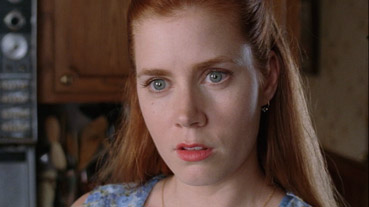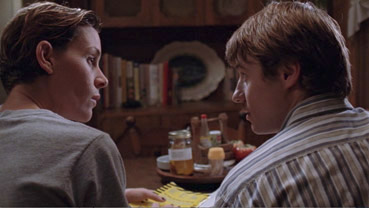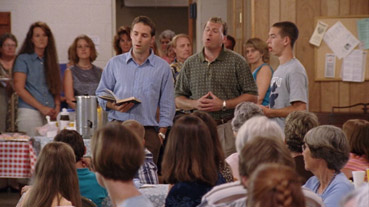|
Stop me if you've heard this one before. A boy falls in
love with and marries a girl who hails from a very different
background to his own, and when he takes her home to meet
his family she has a disruptive effect on them
all. Swap the sexes and you can hop back to 1967 and Stanley
Kramer's Guess Who's Coming to Dinner,
and no doubt a whole load of others that predate it that I can't
pull off the top of my brain at this very second. The encounter usually
proves a learning process for both parties, where pre-judgement
mellows into tolerance and understanding. That's certainly
the gist of the enigmatically titled Junebug.
Here the family are southern country folk and the new wife
is an art dealer from the city. Can you guess how this plays
out? If you think you can, you may be in for a few surprises.
Nice surprises, as it happens.
Given
the opportunities for broad caricature offered by the situation
and characters, one of the first thing that strikes you
about Junebug (I might as well say now
that I'm not going to explain the title, as this can lead
to second guessing on plot development) is that it resists
such temptations and takes an unusually even-handed approach
to all involved. No time is wasted getting the couple at
the film's core together: George and Madeline meet in the
first scene, get real friendly under the opening credits,
and by the time the film proper kicks off have been together for six
months. This is no obvious attraction of opposites either
– Madeline may be the art dealer from the big city, but
George is no rube, and a few minutes into the film
is talking possible deals on his mobile like he was born
to this life. The pair deal in outsider art, and their latest find
just happens to live in the area in which George grew up,
the perfect opportunity to introduce the new wife to the
folks.

To suggest that the film does not send up its characters
would be a little misleading, but it does so in gentle and affectionate
fashion – mother Peg is down-to-earth and practical, husband
Eugene is unhurried to the point of stalling, brother Johnny
is grumpy and uncommunicative, and sister-in-law Ashley
is heavily pregnant and gets wide-eyed with enthusiasm at
anything Madeline says or does. At first played largely
for fun, the characters are soon shown to have considerably
more depth than first encounters suggest. Johnny in particular
appears to be hiding behind a mask of annoyance at just
about everything, from his brother's success to the prospect
of his wife – to whom he appears gruffly indifferent – giving
birth to their child. At his workplace, however, he is a different man,
cheerful and jocular and openly communicative with those
around him, and his desperate fury at being unable to record
a TV programme for Ashley speaks volumes about his underlying
devotion to his wife.
The
familiarity of plot elements soon becomes irrelevant, rendered
fresh as they are by the setting and sometimes delicious
character detail. Here the characters are everything and
the narrative is always driven forward by them. Even a
potential show-stopper in which George sings a hymn at the
local church – staged partly for the song and its angelic
delivery – is still primarily about story and character
development. Personally, I've always found such songs rather creepy
and this one is no exception, but the scene still works
for the film through the responses of the listeners, particularly Madeline,
who in the six months of their marriage clearly had no inkling
of this aspect of her husband's personality. Inevitably,
it is Madeline who has the most to learn (when
you're in the country it's always the townies who are out
of step), and she suffers the emotional punishment that her
failure to read others or properly prioritise inevitably
brings.
Junebug is hardly innovative in its style or structure, but its
attention to character detail nonetheless separates it from
many an independent American feature and just about any recent mainstream
Hollywood film you care to name. Its unhurried narrative
perfectly reflects the pace of life of its setting, and
the performances are delight, notably Amy
Adams as Ashley, whose exuberant, child-like enthusiasm
is played just the right side of parody, and whose final
scene reveals, as with all of the family members, that there
is far more to this girl, emotionally and intellectually,
than we are first led to believe. Everyone has their
moments, but my favourite belongs to the resolutely
unflustered Eugene, as he potters in his basement workshop
in search of a missing tool, and wonders aloud to himself, "Where
would I be...if I was a screwdriver?"
Anamorphic
1.85:1, the film was shot on Super-16 – becoming a very
popular format for low budget filmmakers who do not want
to go digital – and is in impressive shape. Detail is very
good, and there is little evidence of the sort of grain you
might expect from a 16mm blow-up. Contrast and colour are
about right – there appears to be a deliberate use of softer,
more pastel shades than primaries throughout the film, but
flesh tones and black levels are on the nose.

The
5.1 surround track is, as you'd expect, an unflashy affair,
with only music making active use of the rears. Clarity
and dynamic range are fine.
Eureka
have given Junebug a 2-disc 'deluxe edition' release and
included a number of extra features, most of which are on
disc 2.
The
one extra included on disc 1 is an audio commentary by lead actors Embeth Davidtz and Amy Adams, who play
Madeline and Ashley respectively. Although a confirmed fan of commentary
tracks, I actually found this one hard work at times. It's
certainly lively enough and there are a few interesting
behind-the-scenes stories, but there is a bit too much gushy
back-slapping and "I love this..." style observations
for my rather cynical ears. Davidtz also has a slightly
tiring habit of calling just about everyone on the shoot
"a genius," but you are left in no doubt that
this was a very special experience for both of them.
Disc
2 kicks off with 10 deleted scenes
(21:21 total), which are non-anamorphic 1.85:1 and timecoded,
but otherwise in fine shape. There is no commentary to explain
why the scenes were lopped, but almost all are of intriguing, usually adding character detail and even
the odd bit of narrative information. Three are separate
angles on the same sequence, and the last of them, which runs
for a substantial six-and-a-half minutes, expands considerably
on the film's final scene, though it could also be argued
that it makes more explicit things that are better left suggested.
Either way, it's a worthwhile inclusion.
Behind
the Scenes consists of five short featurettes:
Places and Faces (3:33), Singing
a Hymn (5:24), Meerkats Gone Wild
(3:06), Ashley (2:37), All
About Peg (2:50). A mixture of interviews
with cast members, behind-the-scenes footage and film extracts,
they are all of interest, but do have the feel of bite-sized
EPKs.

Amy
Adams Q&A (21:49) was shot on the 12 March
2006 at the Soho Hotel in London following a screening of
the film. Decently covered by multiple cameras, the interview
itself provides some interesting background to the film
and Adams' interpretation of her role. The actress and her
interviewee are given separate sound channels, which can
catch you out if your speakers are widely spaced. As far
as I am aware, this is the only feature unique to this UK release.
There
are two casting sessions, one
for Amy Adams (13:58), the other
for Ben McKenzie (7:18), who plays
Johnny. It's always interesting to see a performance before
it is fully honed and stripped of the polish of lighting,
costume and sound mixing, but it's clear that the two actors
here already had a very good handle on their roles.
Finally, Ann Wood is a slideshow
of the paintings of Madeline and George's new discovery,
David Wark, which were actually created by, you've guessed
it, artist Ann Wood.
Junebug is a well observed and pleasingly unhurried story of family
and community that occasionally skirts close to cliché,
but always manages to pull back before it topples. Consistently
engaging, it lives in its small moments, its character detail,
its well judged performances, and Phil Morrison's almost
invisible direction.
Eureka's
2-disc DVD is essentially a port of Sony's region 1 release,
but with the added extra of the Amy Adams Q&A. Although
not reason enough for owners of the region 1 disc to re-purchase,
for the majority of UK viewers coming relatively
new to the film, this is a largely fine package that should
be sought out by anyone who prefers their movies to talk
rather than shout, and to be about people rather than spectacle.
|